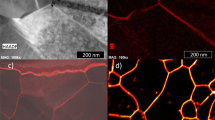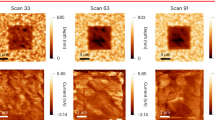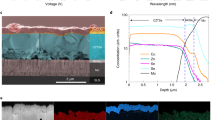Abstract
The influence of microstructural defects on the device properties in CdTe remains largely unknown. This is partly because characterization techniques have been unable to image electrical pathways throughout three-dimensional grains and grain boundaries with nanoscale resolution. Here, we employ a conductive and tomographic variation of atomic force microscopy to study charge transport at the nanoscale in a functioning thin-film solar cell with 12.3% efficiency. Images of electric current collected through the device thickness reveal spatially dependent short-circuit and open-circuit performance, and confirm that grain boundaries are preferential pathways for electron transport. Results on samples with and without cadmium chloride treatment reveal little difference in grain structure at the microscale, with samples without treatment showing almost no photocurrent either at planar defects or at grain boundaries. Our results supports an energetically orthogonal transport system of grain boundaries and interconnected planar defects as contributing to optimal solar cell performance, contrary to the conventional wisdom of the deleterious role of planar defects on polycrystalline thin-film solar cells.
This is a preview of subscription content, access via your institution
Access options
Subscribe to this journal
Receive 12 digital issues and online access to articles
$119.00 per year
only $9.92 per issue
Buy this article
- Purchase on Springer Link
- Instant access to full article PDF
Prices may be subject to local taxes which are calculated during checkout





Similar content being viewed by others

References
Kumar, S. G. & Rao, K. S. R. K. Physics and chemistry of CdTe/CdS thin film heterojunction photovoltaic devices: fundamental and critical aspects. Energy Environ. Sci. 7, 45–102 (2014).
Li, H., Liu, X. X., Lin, Y. S., Yang, B. & Du, Z. M. Enhanced electrical properties at boundaries including twin boundaries of polycrystalline CdTe thin-film solar cells. Phys. Chem. Chem. Phys. 17, 11150–11155 (2015).
Al-Jassim, M. et al. TEM and AFM, and cathodoluminescence characterization of CdTe thin films. Thin Solid Films 387, 246–250 (2001).
Sites, J., Granata, J. & Hiltner, J. Losses due to polycrystallinity in thin-film and solar cells. Solar Energy Mater. Solar Cells 55, 43–50 (1998).
Durose, K. et al. Key aspects of CdTe/CdS solar cells. Phys. Status Solidi B 229, 1055–1064 (2002).
Moseley, J. et al. Recombination by grain-boundary type in CdTe. J. Appl. Phys. 118, 025702 (2015).
Poplawsky, J. D. et al. Direct imaging of Cl- and Cu-induced short-circuit efficiency changes in CdTe solar cells. Adv. Energy Mater. 4, 1400454 (2014).
Visoly-Fisher, I., Cohen, S. R., Ruzin, A. & Cahen, D. How polycrystalline; devices can outperform single-crystal ones: thin film CdTe/CdS solar cells. Adv. Mater. 16, 879–883 (2004).
Loginov, Y. et al. Transmission electron microscopy of CdTe/CdS based solar cells. J. Cryst. Growth 161, 159–163 (1996).
Abbas, A. et al. The effect of cadmium chloride treatment on close-spaced sublimated cadmium telluride thin-film solar cells. IEEE J. Photovolt. 3, 1361–1366 (2013).
Al-Jassim, M., Dhere, D., Jones, K., Hasoon, S. & Sheldon, P. The Morphology, Microstructure, and Luminescent Properties of CdS/CdTe Films NREL/CP-520-25101 (1998); http://www.nrel.gov/docs/legosti/fy98/25122.pdf
Terheggen, M. et al. Analysis of bulk and interface phenomena and in CdTe/CdS thin-film solar cells. Interface Sci. 12, 259–266 (2004).
Maniscalco, B. et al. The activation of thin film CdTe solar cells using alternative chlorine containing compounds. Thin Solid Films 582, 115–119 (2014).
Terheggen, M. et al. Structural and chemical interface characterization of CdTe solar cells by transmission electron microscopy. Thin Solid Films 431, 262–266 (2003).
Yan, Y., Al-Jassim, M. M., Jones, K. M., Wei, S.-H. & Zhang, S. B. Observation and first-principles calculation of buried wurtzite phases in zinc-blende CdTe thin films. Appl. Phys. Lett. 77, 1461–1463 (2000).
McCandless, B. & Rykov, S. Cross-section potential analysis of CdTe/CdS solar cells by Kelvin probe force microscopy. Photovolt. Spec. Conf. 978, 4244 (2008).
Visoly-Fisher, I., Cohen, S. R., Cahen, D. & Ferekides, C. S. Electronically active layers and interfaces in polycrystalline devices: cross-section mapping of CdS/CdTe solar cells. Appl. Phys. Lett. 83, 4924–4926 (2003).
Edwards, P., Galloway, S. & Durose, K. EBIC and luminescence mapping of CdTe/CdS solar cells. Thin Solid Films 372, 284–291 (2000).
Corwine, C., Pudov, A., Gloeckler, M., Demtsu, S. & Sites, J. Copper inclusion and migration from the back contact in CdTe solar cells. Solar Energy Mater. Solar Cells 82, 481–489 (2004).
Tseng, A. A. Removing material using atomic force microscopy with single- and multiple-tip sources. Small 7, 3409–3427 (2011).
Knoll, A. W. et al. Probe-based 3-d nanolithography using self-amplified depolymerization polymers. Adv. Mater. 22, 3361–3365 (2010).
Pires, D. et al. Nanoscale three-dimensional patterning of molecular resists by scanning probes. Science 328, 732–735 (2010).
Celano, U. et al. Scanning probe microscopy as a scalpel to probe filament formation in conductive bridging memory devices. Microelectron. Eng. 120, 67–70 (2014).
Celano, U. et al. Conductive-afm tomography for 3d filament observation in resistive switching devices. IEEE IEDM Proc. 21, 4 (2013).
Celano, U. et al. Three-dimensional observation of the conductive filament in nanoscaled resistive memory devices. Nano Lett. 14, 2401–2406 (2014).
Diederich, L., Kttel, O., Aebi, P. & Schlapbach, L. Electron affinity and work function of differently oriented and doped diamond surfaces determined by photoelectron spectroscopy. Surf. Sci. 418, 219–239 (1998).
Sadewasser, S., Glatzel, T., Rusu, M., Jäger-Waldau, A. & Lux-Steiner, M. High-resolution work function imaging of single grains of semiconductor surfaces. Appl. Phys. Lett. 80, 2979–2981 (2002).
Visoly-Fisher, I., Cohen, S., Gartsman, K., Ruzin, A. & Cahen, D. Understanding the beneficial role of grain boundaries in polycrystalline solar cells from single-grain-boundary scanning probe microscopy. Adv. Funct. Mater. 16, 649–660 (2006).
Kutes, Y. et al. Mapping photovoltaic performance with nanoscale resolution. Prog. Photovolt. 24, 315–325 (2015).
Giannuzzi, L. A., Drown, J. L., Brown, S. R., Irwin, R. B. & Stevie, F. A. Applications of the FIB and lift-out technique for TEM specimen preparation. Microsc. Res. Tech. 41, 285–290 (1998).
O’Dea, J., Brown, L., Hoepker, N., Marohn, J. & Sadewasser, S. Scanned probe microscopy of solar cells. MRS Bull. 37, 642–650 (2012).
Green, M. A. & Wenham, S. R. Novel parallel multijunction solar cell. Appl. Phys. Lett. 65, 2907–2909 (1994).
Kannan, B., Castelino, K. & Majumdar, A. Design of nanostructured hetero-junction polymer photovoltaic devices. Nano Lett. 3, 1729–1733 (2003).
Cahen, D., Hodes, G., Graetzel, M., Guillemoles, J. F. & Riess, I. Nature of photovoltaic action in dye-sensitized solar cells. J. Phys. Chem. B 104, 2053–2059 (2000).
McCandless, B. E., Moulton, L. V. & Birkmire, R. W. Recrystallization and sulfur diffusion in CdCl2-treated CdTe/CdS thin films. Prog. Photovolt. 5, 249–260 (1997).
Acknowledgements
J.L. acknowledges support from the US Department of Energy, Office of Energy Efficiency and Renewable Energy (EERE) Postdoctoral Research Awards under the SunShot Solar Energy Technologies Program. Y.K. and B.D.H. recognize DOE-BES-ESPM project DE-SC0005037. This research used resources of the Center for Functional Nanomaterials, which is a US DOE Office of Science Facility, at Brookhaven National Laboratory under Contract No. DE-SC0012704. Authors acknowledge Kim Kisslinger for his assistance in cross-sectional TEM, and James Steffes for work on temperature dependence. Support from Jim Sites at Colorado State University is appreciated.
Author information
Authors and Affiliations
Contributions
J.L. performed CT-AFM experiments, assisted by Y.K.; A.M. was responsible for fabrication of samples. TEM work led by E.A.S., including work from L.Z. The manuscript was written by J.L. and B.D.H. All authors discussed the results and reviewed the manuscript.
Corresponding authors
Ethics declarations
Competing interests
The authors declare no competing financial interests.
Supplementary information
Supplementary Information
Supplementary Notes 1–5, Supplementary Figures 1–11. (PDF 2334 kb)
Supplementary Video 1
Photoconductivity Tomography in a CdTe Thin-Film. Illuminated with 15 suns of intensity, the brightness contrast of these images are from 0 pA (dark) to 30 pA (bright) and z-scale at 2.2 microns. Although sampled from the top of the film to the bottom of the film, we present an array of side-profiles to show the capabilities of tomography. (AVI 2773 kb)
Rights and permissions
About this article
Cite this article
Luria, J., Kutes, Y., Moore, A. et al. Charge transport in CdTe solar cells revealed by conductive tomographic atomic force microscopy. Nat Energy 1, 16150 (2016). https://doi.org/10.1038/nenergy.2016.150
Received:
Accepted:
Published:
DOI: https://doi.org/10.1038/nenergy.2016.150
This article is cited by
-
Anomalous 3D nanoscale photoconduction in hybrid perovskite semiconductors revealed by tomographic atomic force microscopy
Nature Communications (2020)
-
Fossil Fuels Environmental Challenges and the Role of Solar Photovoltaic Technology Advances in Fast Tracking Hybrid Renewable Energy System
International Journal of Precision Engineering and Manufacturing-Green Technology (2020)
-
Direct nanoscale mapping of open circuit voltages at local back surface fields for PERC solar cells
Journal of Materials Science (2020)
-
Scanning probe microscopy for advanced nanoelectronics
Nature Electronics (2019)
-
Nanoscale imaging of charge carrier transport in water splitting photoanodes
Nature Communications (2018)


